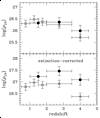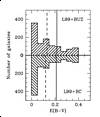
| Figure 1 -
Redshift evolution of the comoving UV luminosity density (in
log unit of ergs/s/Hz/Mpc^3), as sampled by the
HDF-N galaxies. The apparent value of ρ_(1500) at 1500 A,
from the data in Table 1, is displayed in the upper panel, while its
trend after correction for dust absorption is reported in the lower
panel. Our results (solid dots) are compared with the Madau et al. (1998) 1500 A
data at z > 2 (triangles), and with the 2800 A estimates of Connolly et al. (1997)
at z < 2 (squares). Error bars on the points try to account for a
more realistic error estimates including field-to-field variations
(see Fontana et al 1999) and the errors induced by the unknown
incompleteness of the sample studied. |

| Figure 2 -
Color excess distribution of the HDF-N galaxies, according to
our SED fitting comparing the output of the L99+BUZ and L99+BC
reference sets of galaxy templates. The best-fit value of E(B-V) for
the 1067 galaxies in the sample is displayed together with the
computed values of E(B-V)_ave (dashed lines) and
E(B-V)_eff (solid lines), as discussed in the text. |

| Figure 3 -
Inferred cosmic SFRD according to the evolution of the
extinction-corrected comoving UV luminosity density, ρ_(1500),
from the data of Table 1 (solid dots). Our calibration is from
eq. (3), with α_1500 = 8.3 10^27 ergs/s/Hz.
Once accounting for dust absorption, our data from the HDF-N galaxies
are consistent with the SCUBA far-IR background estimates from Barger et al. (2000)
(stars) indicating a non-decreasing SFRD at least up to z ~3. |


